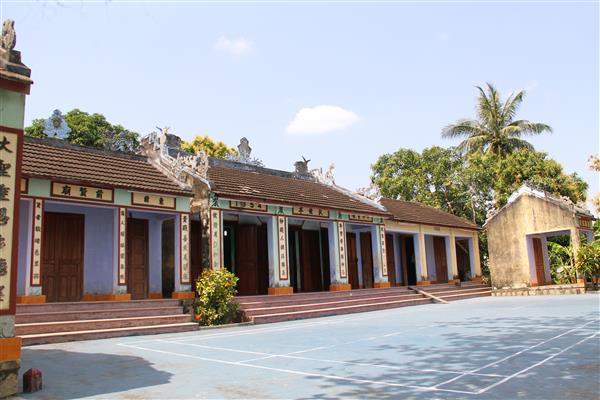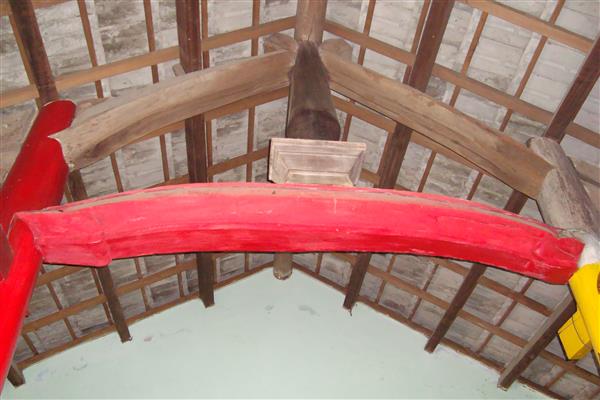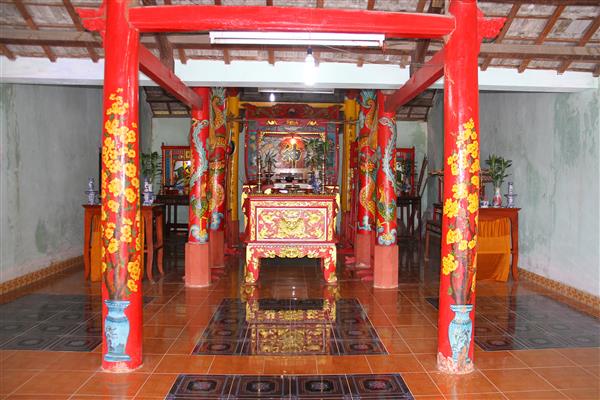Description
Vo Kien communal house belongs to Vo Kien village, Dien An commune, Dien Khanh district, Khanh Hoa province (formerly belonging to Vo Cang Tay commune, Cang Ha, Phuoc Dien district, Dien Khanh district).
The communal house is located at the beginning of the village, in the past, the communal house was built on the bordering land between the two villages of Vo Cang Dong (Vo Dong) and Vo Cang Tay (Vo Kien). Today, the ground floor of the communal house still has traces of the old brick foundation, hidden under the rice fields, which is known as Go Dinh land. In 1820, Vo Kien communal house was moved to a customary land called Dong Moc land, where the communal house is now located.
Vo Kien communal house was built around the beginning of the 19th century, to worship Ban Canh Thanh Hoang, Dai Can National Nam Hai, Ngu Hanh, Tien Hien, Hau Hien…
Over time with the ups and downs of history, along with the harsh weather, the house has deteriorated and the people have repeatedly restored the monument. In 1954, the family was restored. In 1973, the communal house was restored and built with brick and cement walls and re-roofed with tiles.
The relic is located on a campus of 1,371m2, the architectural units are arranged in width including: Nghi Mon, Phong Nha, communal house yard, great communal house, Dong house, Tien Hien temple, Son Lam temple and so on. Temple of Five Elements. The buildings are all facing northeast.

The layout of Vo Kien communal house
The great communal house is arranged in the style of the second letter, consisting of two parts: the main hall and the main hall. The sacrifice is designed as a one-room, two-wing house, with an area of 34.05m2, with three doors, the wings are made of wood. The sacrifice is the place where people sacrifice their offerings to God every time a festival takes place. In the middle of the roof bank of the decorative embossed "Carp crossing the dance floor", the two sides of the roof are designed quite nicely with four "Dragon heads", facing both sides; on the banks of the strip decorated with stylized dragon and cloud pattern.
The main hall is also designed in the style of one compartment and two wings, with an area of 50.02m2. In the middle of the roof is decorated embossed with the image of "Two dragons adoring the moon", below is the image of "Ho Phu", on both sides are four mascots "Lan Chau", the banks are decorated with stylized dragons and clouds.

Wooden frame architecture in the style of traditional pig belly
The sacrifice and the main hall have four sets in total because, made in the style of a traditional pig belly, eight female columns and two military columns, along with a system of diaphragms, rui, sesame, rods, etc. Mortise, scientifically designed, creates a solid bearing system with a wooden frame.
A special thing of great value in terms of history and culture is that Vo Kien communal house still retains many ancient relics. The relics here are quite rich in genres and materials such as: 11 ordinations of the Nguyen kings period, god worshiping temple, long communal house, double parasol, hole set, gong, drum, Thanh la... In addition, The family also preserves intangible cultural heritage: rituals, worshiping rituals, worshiping texts, worshiping music, etc. The ordinations include:
- Ordaining Tu Duc in the 5th year (1852) conferred on the Dai Can Quoc Nam Hai four deities;
- Ordaining Tu Duc in the 5th year (1852) to Cao Cac;
- Ordaining Tu Duc in the 33rd year (1880) to Cao Cac;
- Ordaining Tu Duc in the 33rd year (1880) conferred on the Dai Can Quoc Nam Hai four deities;
- Ordaining Dong Khanh in the 2nd year (1887) for Cao Cac;
- Ordaining Dong Khanh in the 2nd year (1887) conferred on the Nam Hai Dai Cang the four deities;
- Ordaining Duy Tan in the 3rd year (1909) conferred on the Nam Hai Dai Cang the four deities;
- Ordained Duy Tan in the 3rd year (1909) conferred on Cao Cac;
- Ordaining Khai Dinh in the 9th year (1924) conferring the title of Dai Cang on Nam Hai with four deities;
- Ordaining Khai Dinh in the 9th year (1924) conferred on Cao Cac;
- Ordaining Khai Dinh in the 9th year (1924) for Ngu Hanh.

The main hall of Vo Kien communal house
The communal house of Vo Kien village during the resistance war against the French colonialists is also the place to save many historical events. The communal house is the meeting place of the people, organizing the training of the defense forces, the place where rallies of the Viet Minh front took place to call on the masses to rebel to seize power in villages and districts.
Every year, on the 9th and 10th of the third lunar month, people organize a festival, in addition to the ceremony, there is also a festival (singing boi) to serve the people to have fun and enjoy.
With the typical values on the relic, the People's Committee of Khanh Hoa province issued Decision No. 2862/QD-UBND, on 11/11/2009 ranked as a provincial historical - cultural relic.